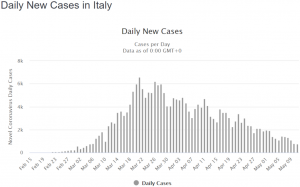get these updates easily
I don’t know about you, but things can seem a little daunting at times. Whether it’s a downturn in the economy or challenges at work, usually we can just put our heads down and muscle through it. But what do we do when those challenges persist day after day? Like a global pandemic, lay-offs at work, loss of income, or lock down? It can be challenging to overcome pessimism, practice optimism, stay resilient.
Here’s a way to stay resilient in challenging times – practice Optimism.
The reality
These are challenging times! According to Worldometers as of May 11, 2020 the corona virus has infected over 4 million people world-wide, with over 280,000 deaths.
 Download from world wide web May 11 2020
Download from world wide web May 11 2020This year, the US economy has lost over 20 million jobs and Oxford Economics forecasts Covid-19 will ‘crush’ global trade by 10-15%. Global travel restrictions have put some 75 million tourism jobs at risk and the BBC suggests this is the worst economic crisis since the great depression. There’s been over 2 million jobs lost in Canada alone with unemployment rates at 13%. Economists are saying it will take at least 2 years for the economy to recover.
There’s been shortages of ventilators, hand sanitizers and toilet paper. People are citing depression, frustration, and defiance after working some 6 weeks from home. If you’re thinking ‘no amount of optimism is going to help that’, no one would blame you.
But there’s another reality
Over 1.5 million people have recovered from the Virus. Many countries are already flattening the curve with new cases declining even in countries like the U.S., United Kingdom, Italy, and France.

Strategies like social distancing, lock downs, and testing are working. China shared key learning’s early on allowing other nations to prepare. Countries like New Zealand, Slovenia, and Greece took decisive action and were able to minimize the impact. We’ve applied lessons from past pandemics like the Spanish Flu, AIDS, and SARS.
Countries have introduced financial assistance measures for individuals who’ve lost their jobs. Scientists have been working together to create a vaccine. The World Economic Forum says that during this pandemic, there’s been an overall improvement in air quality.
Communities are celebrating everyday heroes and many people like working from home, spending time with family and forgoing the commute. So, there’s that.
Which reality would you choose?
Well that’s a trick question of course, because they’re both ‘reality’. Both perspectives are accurate (if you trust the sources). It’s true that people contract Covid-19 and it’s true that many people recover. It’s true that people have been laid off and it’s true some companies have found ways to keep their people meaningfully employed. So why all the negative news?
We’re good at the negative reality.
As I mentioned in my article on 5 words that kill Innovation, we’re trained to be critical thinkers. From the time we’re children we learn games like ‘which one of these doesn’t belong’. The best lawyers are the ones who find the most fault in the other lawyer’s argument. In Socrates time if an idea could withstand tremendous criticism – then it must be true.
In organizations we teach people risk management, quality control, and ‘post mortem’s on past projects to identify what went wrong. These are helpful things to do, but if that’s all we do, we’re missing another reality.
In their earnest efforts to keep us informed, TV and internet media teams provide round-the-clock updates on those issues impacting our lives. In the case of Covid-19, it’s important that we know that there’s a pandemic, that the risks are high, and the impact potentially deadly. But to the degree we focus exclusively on the negative, it can undermine our motivation to look for solutions. It’s almost as if we’re thinking, ‘what’s the use’?
Avoidance Motivation
U.S. president Donald Trump has been teased for his early prediction that the Corona Virus would ‘magically go away’ in the spring. That’s not optimism, that’s what psychologists term Avoidance Motivation. Where the fear of failure is so high that we’d rather just avoid it than deal with it.
I can relate to this. When I’m faced with a daunting task where there’s a good chance I might fail, I tend to procrastinate, to avoid it. There’s a part of me right now, that’s waiting for the Corona Virus to be over – so I can get back to work. Probably not the best strategy, do you think?
Learned Helplessness
In his book Learned Optimism, Dr. Martin Seligman shared his findings from his extensive research in the field of pessimism and optimism. He coined the term Learned Helplessness after his experiments revealed that when faced with repeated stressful situations that seemed insurmountable, people could learn to become helpless. In other words, they come to believe that they are unable to control or change the situation, so they do not try — even when opportunities for change become available.
What if you’re just born pessimistic?
In his research on optimism, Dr. Seligman found that some people seemed to have a pessimistic explanatory style while others had a more optimistic explanatory style. In other words, their way of explaining or making sense of a situation or outcome was either pessimistic or optimistic.
Let’s say that two people take a Math test and both people fail the test.

A person with a more pessimistic explanatory style tends to see negative events as personal, pervasive, and permanent. They might say things like:
- I’m just not good at math (personal)
- I’m not good at anything with numbers. (pervasive)
- I’ll never learn statistics. (permanent)
Guess what happens if he passes the test? He might say things like
- the test was easy. (external)
- It was just this test. (specific)
- I was lucky this time. (temporary)

Office coworkers talking during meeting together in design studio
A person with a more optimistic explanatory style tends to see negative events as external, specific, and temporary. They might say things like:
- That test was hard (external)
- It was just this math test I failed. (specific)
- I’ll study harder next time. (temporary)
Pass the test? She might say something like:
- I studied hard for this test. (personal)
- I learn new things easily. (pervasive).
- With these study habits I’ll earn my CPA for sure. (permanent).
Can we overcome pessimism?
Pessimism does have it’s place. It allows us to anticipate things that might harm us, our company or the world. It can keep us from introducing a new product that hurts a customer or save us from an on-line fraud scheme. When it holds us back from making changes that would be good for us, it’s time to balance that with a little optimism.
Whether you (or your employees) seem to be more pessimistic or not, there’s a way to overcome pessimism, practice optimism, and stay resilient
- Carol Dweck; Fixed vs Growth Mindset. To the degree I believe I’m capable of learning new things, I’m more likely to learn successfully.
- Dr. Martin Seligman; Learned Optimism. Through practicing specific behaviors, I can learn to be more optimistic.
- Anders Ericsson: Peak. You can master anything if you’re willing to put in the practice. (similar to the 10,000 hours rule but with science).
What is Optimism?
Optimism is having a sense of hope and a belief that there is potential for positive outcomes in the future. While some people would argue you’re either born that way or not, it’s not on or off, all or none. We all have some degree of optimism, or we’d be hiding under a rock afraid to come out.
When we allow for the possibility of a positive outcome, we are more likely to approach the situation, use our creative problem solving, and take action to improve the situation. Though people can be accused of ‘wearing rose colored glasses’ it’s not about wishful thinking. It’s about developing a mind set that can give you an element of control. Now you’re more motivated to take action.
As Anthony Robbins once quipped. ‘If you have weeds in your garden, thinking “there are no weeds, there are no weeds” is not going to help. Instead, admit there are weeds, pull them out, and plant flowers!’
An example of optimism
The pandemic hit. Restaurants closed, bars closed, and people were staying home. Craft beer sales plummeted. If you were a brewery owner and thought ‘there’s nothing we can do but to lay everyone off and wait for this pandemic to pass’, you would not have been alone. Enter Parallel 49 , a craft brewery, who, looking for ways to keep their staff gainfully employed, pivoted quickly to start producing cans of hand sanitizers to help with the shortage. Or how about car companies like Ford and TESLA changing their factory lines to produce ventilators. It’s doubtful these resourceful solutions would have been created without a sense of optimism. Here are 10 more examples of resourceful thinking during this time.
Practice Optimism
Even if you are optimistic, you can help others to be more optimistic, even if it seems they weren’t born that way.
Here are 6 specific things people can practice that can help them to develop a more optimistic outlook.
1: Notice your self-talk
Notice what you say to yourself day to day. For instance, when you see someone and you can’t remember their name, do you catch yourself saying ‘I’m so bad at remembering names’? Or do you say something like ‘that’s weird, usually I remember names easily. I’ll make a point of remembering Jim’s name’. If you have trouble joining a zoom meeting, do you catch yourself saying ‘I’ll never get this technology thing’, or more like ‘next time I’ll click on the zoom link 5 minutes early and test the audio so I’m ready’.
Though a lot of my friends and colleagues think I’m optimistic, negative self-talk is something I really have to work on. In his research, Seligman found that pessimists tended to ruminate more – meaning – when they did something cringe worthy, (I’m an expert at that… whoops, see?) they will relive that moment in their mind, over and over. The effect on their brain is as if they really did do that ‘thing’ multiples times. For me, it takes work. Notice your self-talk.
2: Challenge negative self-talk
If you notice your self-talk is negative:
- Stop. Interrupt or distract yourself. I’ve heard some people say ‘delete’ after saying something negative. Interrupt the pattern.
- Challenge. ‘I’m not stupid, I’ve simply misplaced my keys’. Or ‘I am a few minutes late this time but I’m not ‘always’ late.
- Recall past successes. I had a friend who had quit smoking for 5 days straight. After having one cigarette she said, ‘I’m such a loser I can’t even quit smoking’. She had been successful 20 times a day for 5 days straight. That’s not ignoring the truth, it IS the truth!
3: Create positive self-talk
If you’re rolling your eyes right now, I don’t blame you. If you read my article on gratitude, you know that simply being grateful can build your resilience. This is slightly different. Similar to recalling past success, this is about replacing negative self-talk with more supportive talk. ‘I plan ahead so I’m always on time’. ‘I follow through on my promises quickly’. ‘when I’m focus, I can spot project risks quickly’. Even if you feel you’re aspiring to do more of something, self-talk can help you move in the right direction; ‘I take time regularly to check in on people and ask how they are doing.’
4: Make a Plan
Remember, if you just think optimistically and hope things will get better without taking action, it is just wishful thinking. You all know the SMART method of setting goals, here’s a simplified version:
- Focus on what you want. Instead of thinking ‘why am I so forgetful’, think, ‘I want to remember (names, login passwords, car keys) easily’.
- Create a strategy. ‘3 days a week, I’ll lay out my workout gear the night before, set my alarm for 6:00 am, and workout first thing.’
- Ask for help. We’ll often do more for others than we will for ourselves. Let someone know what you’re up to and ask for support.
5: Take Action
‘Duh’ right? Well I don’t know about you, but I’ve made thousands of SMART plans in the past, that I never moved on. I’ve also seen the MAGIC of taking just one step toward your goal(s). Taking action:
- Creates momentum
- Allows you to track what is working, and what is not
- Creates an experience of success so you’re motivated to keep going
- Starts to embed new neural pathways and helps create a habit.
6: Celebrate Success
Take time to stop and acknowledge the successes and effort you have made along the way. This is key for several reasons. It reinforces the behaviors you’re practicing, that lead to more optimism. Our mindsets impact our beliefs, our beliefs impact our behaviors and our behaviors create the results we get. Those results or experiences in turn impact our mindset. As we create new experiences we’re shifting our mindset. Celebrating success reminds you that a better future is possible – that’s optimism.
Overcome pessimism, practice optimism, stay resilient
Remember, as a leader, you need to be resilient, in order to lead others successfully. And optimism is one thing that can help build resilience.
Chances are you’re someone that already has an optimistic mindset. Then use some of these ideas as you’re coaching your employees, or listening to a colleague, or supporting your boss.
There are so many things we can do to help develop a more optimistic outlook and I’ve only named a few. Here’s a link to 13 more!
I hope you’ll try these 6 steps. If that seems daunting, start with #1 and notice your self-talk for week. Or take action on a goal you seem to have been avoiding. With an optimistic outlook, you’ll see more possibilities, be more resourceful, and more willing to move to action.
- Notice your self-talk
- Challenge negative self-talk
- Create positive self-talk
- Make a plan
- Take action
- Celebrate success
Interested in more on resilience? Try these articles:


Recent Comments